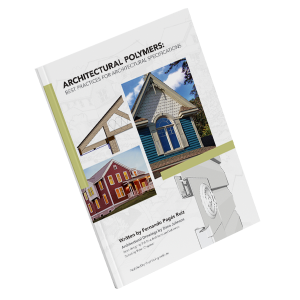
Architectural Polymers: Best Practices for Specifications is a new practical guide written by Vinyl Siding Institute (VSI) consultant and author Fernando Pagés Ruiz and designed by PEL•ONA Architects & Urbanists, both subject matter experts in the New Urbanism movement.
Sponsored by VSI, the guide was produced independently of VSI and its members, to give architects a practical approach to designing with polymeric siding.
“If an architect designs a stone house, he does not draw with wood in mind,” said Fernando, an award-winning designer of affordable neighborhoods. “A lot gets lost in translation when architects are drawing for wood and the developers try installing with vinyl. Designers have to think vinyl from the beginning – think vinyl, draw vinyl – and architects need help with that.”
The user-friendly resource was developed based on a recent survey of architects, whose feedback called for succinct, point-by-point visuals and details to help them design with polymeric siding.
“One good detail is worth more than seven paragraphs,” Fernando asserts. “Our new book gives architects what they want in just four chapters. Chapter 4 (Workarounds) is the most important chapter because it deals with handling objections.”
The new guide is a companion piece to the 2019 Architectural Design for Traditional Neighborhoods - an 80-page book that Fernando co-authored. It gives architects viable alternatives to costly suburban developments by using modern materials for traditional community designs. Inspired by the original book, architects now wanted help with the design and more details – literally.
“The new guide is directly responsive to inquiries on how to go about specifying vinyl and polymeric siding,” says Alex Fernandez, VSI’s Director, Advocacy – Governmental Affairs. “Sometimes we take for granted that everyone in the industry is familiar with these materials, but the truth is, that isn’t the case. Texas, Oklahoma and Georgia are examples of places where a tool like this will make a huge difference.”
The timing of the book’s release is quite fortuitous as there is growing demand for more education on specifying polymeric siding. This demand, Fernando maintains, is based on two big issues: the need for greater affordability in building (which has become even more dire during this COVID economy); and performance issues with fiber cement, one of the more popular materials for affordable home developments. “Developers using this cladding are experiencing peeling paint, deteriorating siding and design limitations,” Fernando explains.
Positive Reception in the Design Space
The new guide was well-received when Fernando introduced it at an AIA presentation in Montgomery, Alabama, in August. The architects in attendance found the piece useful in resolving technical questions and were surprised by both vinyl siding’s sustainable benefits (the new book has an appendix dedicated to sustainability) and the extensive variety and creative freedom vinyl siding offers them.
“This book gives architects control over the material,” Fernando notes. “It helps them inform the builders on every detail to ensure correct installation.”
According to Fernando, most architects get very little material training or education on architectural engineering. One of VSI’s stretch goals is to sponsor architectural engineering labs at colleges and universities, but for today’s active architects, the spec book is the next best thing.
“For architects, this book is like that traveling guide that teaches you how to order a beer in French when you’re in Paris. It has cool photos and illustrations and shows architects the alternatives to J-channel, overlapping panels, and how to create thicker trim around windows,” Fernando says.
“Architects don’t like stacked seams, yet they didn’t know we have 25-ft. panel lengths with no seams at all until they read this book. They can write a design code for towns that permits vinyl without compromising architectural appeal. It makes an excellent guide for cities to use for certain areas, especially since they are revising their building codes for modern exteriors that don’t require paint.”
Alex adds: “It is exciting to launch this resource – it is an excellent tool that will help our efforts with local municipalities, state officials and other builders.”
Perhaps the best review of the new book came from Steve Mouzon, principal of Studio Sky and the New Urbanism Guild in Miami: “We should all recognize when a publication does things the genre isn’t supposed to be able to accomplish. It’s a clever architectural specification book, but it’s also a well-illustrated best practice guide and an excellent marketing piece.”
Architectural Polymers: Best Practices for Specifications has dedicated chapters on Profile Considerations, Trim and Ornaments in addition to workarounds. It has hyperlinks containing annotated AutoCAD files for construction drawings, as well as downloadable material specifications and links to environmental, health-safety and building code resources. It is available in PDF format currently and will have a vinyl cover when it is produced in print in 2022.
__________________________________________________________________________________________________________________________________
Don Browne is a writer, entrepreneur and local legislator who believes that the power of words can change the world. He provides unique writing services for clients in the construction, health care, IT and hospitality sectors. He has a passion for small business and start-ups, as well as writing about Irish history, family and corporate biographies. As a homeowner and father of four who is passionate about community development, Don looks forward to writing more about the exciting possibilities of creating traditional neighborhoods and more sustainable communities using modern materials.